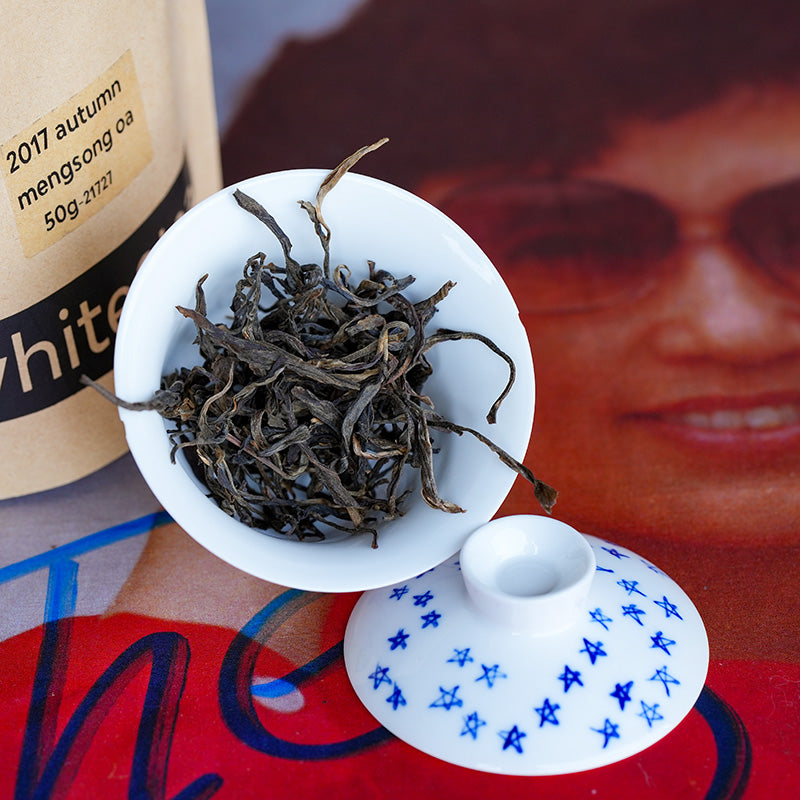Raw and ripe Puer are both fermented teas from China, but despite belonging to the same category, they have significant differences. Raw Puer tends to be lively, potent, and sometimes (but not always) exceptionally bitter, while ripe is generally mellow, full-bodied, and often the least bitter of all teas.
Navigating the ins and outs of raw and ripe Puer tea can be a confusing endeavor, but luckily you’ve got a guide who has been living in China and drinking Puer tea for about two decades to break it down in practical terms. We will help you nail down the differences of terminology, identify the main differences between the tea types, and even help you choose the right tea for you based on your own tastes. With our help, you’ll find that Puer tea is a lot easier to understand than you might think.
What are the different types of Puer tea?
Puer tea has two main categories, raw/sheng Puer tea and ripe/shou Puer tea. You might also see raw Puer tea called "sheng," “green,” or “qing” Puer, or see ripe Puer tea called "shou," “cooked,” or “red” Puer.
All of these names are interchangeable, but for our article we will be calling them raw/sheng and ripe/shou from here on out. The fundamental difference is this: these two teas have the same provincial origin and base leaf material, but shou Puer tea has an additional wet piling step which force ferments and transforms the tea into shou.

Yunnan large leaf varietal, the base material of all Puer tea
What are raw and shou Puer tea made from?
In the same way Champagne is from France, Puer tea by definition is always from the Yunnan province of southwestern China and is always made from a large leaf varietal called dayezhong in Mandarin Chinese or Camellia Sinensis Assamica if you’ve got your lab coat on.
We will get further into the specifics of raw Puer and ripe Puer definitions and sub-genres like aged tea below, but armed with the knowledge above, if someone is trying to sell you a “Puer tea” from Japan made from a green tea cultivar, as least you’ll know they’re way off-base and to run in the opposite direction.

A freshly pressed cake of raw Puer tea with typical greenish hues
How are raw Puer and shou Puer made?
Which came first: the chicken or the egg? Puer is easy, we know the answer; raw Puer came first. In fact, shou Puer tea is literally made from raw Puer and can not exist without it. Raw Puer is made from Yunnan large leaf varietal with the following processing steps: picking, withering, dry frying in a cast iron wok to "kill the green" (remove natural enzymes and slow down the oxidation process which would otherwise turn it into black tea), rolling and then sun-drying.
This process results in the finished product of raw Puer tea called maocha (loose leaf material). At this stage, the raw Puer is typically pressed into cakes called bingcha for easy storage and shipping.
In contrast, shou Puer takes this processed raw Puer maocha and develops it a step further, with a wet piling fermentation process that transforms the raw Puer into shou Puer. Like raw Puer, ripe Puer is also most often pressed into cakes as a final step once the production process is complete.

A ripe Puer tea, with its typical reddish brown color, in a gaiwan
The visual differences between raw Puer and shou Puer tea
Maybe you’ve received a tea as a gift and the giver mentioned only that it is “Puer tea”, without clarifying which type it is. Fear not, they are fairly easy to visually identify. When looking at the dry leaf, raw Puer tea will tend to be on the green, gold, and silvery white end of the spectrum when young.
On the other hand, Shou Puer tea will tend to be dark brown, burgundy and blackish. When you steep the tea, darker teas are almost inevitably shou Puer tea, unless you’ve been gifted a very old raw Puer tea, in which case you ought to quickly send your generous friend a thank you note.
An easy way to remember the difference is that raw Puer tea is green/gold like a fresh banana, whereas ripe Puer tea is darker red/brown like an overly ripe banana. If you’re staring at a pressed cake of Puer tea and don’t know which it is, that simple trick will help you correctly identify the tea 9 times out of 10. This also holds true for the brewed tea, raw Puer will brew up on the golden to orange side of the color spectrum, whereas ripe Puer tea tends to be red to brown.
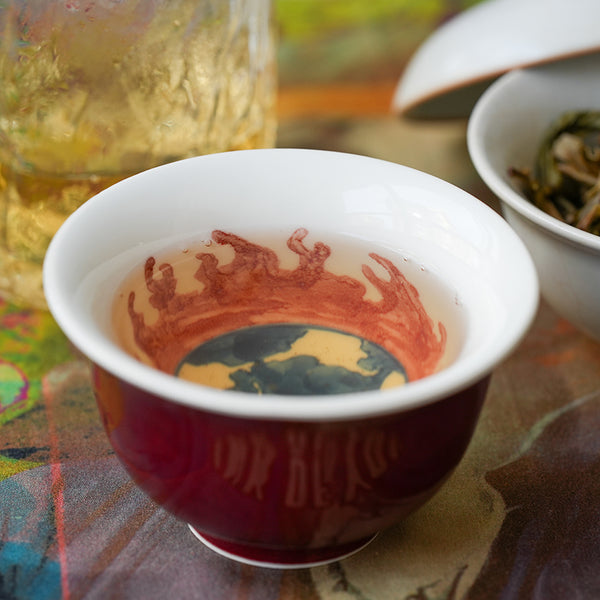
A cup of fresh, young raw Puer tea and its characteristic golden yellow color
What is the main difference between Sheng and Shou?
The main difference between raw Puer tea and shou Puer tea is the character of the tea. Raw Puer tea tends to be intense and brash, with astringency, bitterness and complexity. Shou Puer tea tends to be smooth and full bodied with an easy drinking thickness.
Both categories of tea have a lot of variation, especially raw Puer tea which can vary greatly from tea to tea. The factors that influence a tea are terroir (the region where it was grown), the age of the bushes or trees, the picking/processing, the way the tea was blended and more. It’s quite the rabbit hole, which is why many tea obsessives settle on Puer tea as an end point in their tea journey.
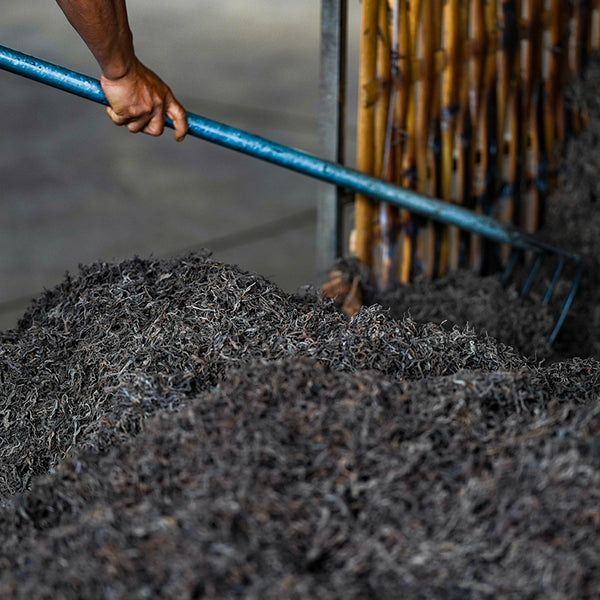
Is raw Puer tea better than shou Puer tea?
One person likes apples and another likes oranges; some people just love fruit. Where raw Puer tea tends to excel is in intensity and complexity. Shou Puer’s greatest assets are its smooth drinkability and soothing nature. Which you prefer is up to you. Personally, we drink both all the time. There’s no need to take up arms for one faction here.
There is a trope that says “shou Puer tea is cheaper than sheng Puer”, but this is actually a misconception. Producing shou Puer tea is actually more expensive, due to a loss of weight during the fermentation pile process. The misconception stems from a historical precedent of using very cheap leftover material for large scale industrial shou Puer production. We have bucked this trend by making small batches of higher quality shou Puer and hope that shou gets more respect in the future.
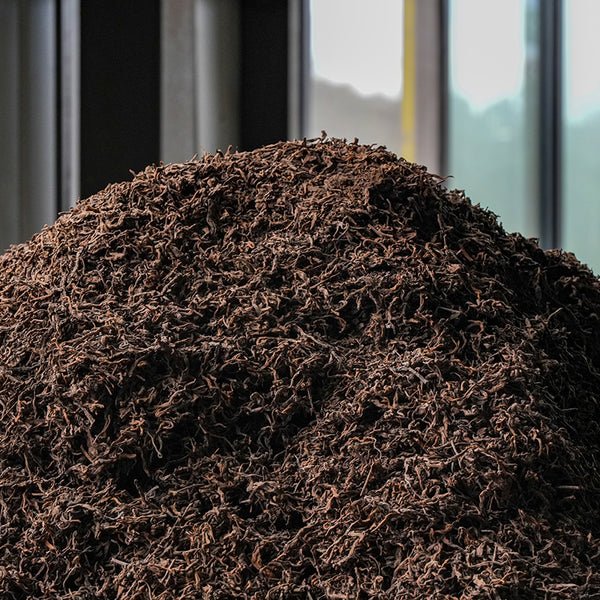
Small batch pile of shou Puer tea, drying after the fermentation process
Can raw Puer tea and shou Puer tea both be aged?
Both raw Puer tea and shou Puer tea benefit from aging. Raw Puer teas are generally aged to reduce and smooth out their bitterness and astringency. Shou Puer teas are often aged to clarify their soup, which can be turbid when the teas are young, and to refine their flavor profile, which can have fishy tastes in youth. (If you buy brand-new shou, you're better off waiting about 6 months to drink it for this reason, but all of white2tea's ripe cakes are adequately rested and free of the strongest wet pile flavors.)
Both teas can also be enjoyed young, and raw Puer in particular has plenty of fans who enjoy drinking it fresh. If you encounter someone who insists Puer must be consumed in a very specific manner, kindly tell them to leave you alone and just drink what you enjoy. Life is too short to be bound by arbitrary restrictions like drinking Puer that is X year old or from Y region. We do recommend gongfu tea brewing for an optimal experience, but there’s no shame in tossing your tea into a mug either.

A fresh raw Puer maocha, with green and gold colors typical of the tea style
Which raw and ripe Puer teas benefit the most from aging?
Aging tends to mellow teas over time, and this is particularly true of Puer. If you think of whisky as an analogy, the reason that a 12 year old single malt Scotch commands a higher price than freshly made moonshine it is because given the right tea aging conditions time softens the harsher edges and deepens the complexity. Typically the teas that benefit the most from aging are any raw Puer tea and ripe Puer teas with lighter fermentation. Although the goal is typical to soften astringency and bitterness over time, even raw Puer teas without much astringency age beautifully, becoming thick, sweet and complex with age.
If you're new to sampling and experiencing these teas, there's one myth we'd like to warn you about: while aging certainly improves quality teas, it does not magically make mediocre Puer into something special. Rather than buy lots of tea early in your journey with a plan to age it for decades, we recommend you buy tea that you enjoy drinking now. Try a range of different raws and ripes, then stock up on what you actually enjoy, and your quality tea collection will inevitably transform over time as you keep it in storage.
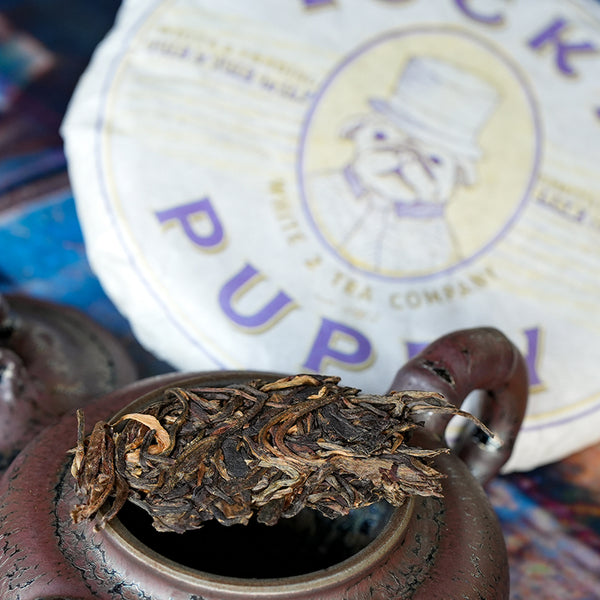
Raw Puer tea that has been aged, notice the previously green colors have turned a darker golden hue
Choosing the right Puer tea for you
Are you more interested in intensity and complexity or a soothing, comforting tea? Raw Puer teas tend to be ideal for tea drinkers seeking an intense experience. Ripe Puer teas tend to be a good option for a thick tea that is soothing on the stomach and easy to drink and brew.
The flavor profile of young raw Puer tea has a broad range. Younger raw can be floral, bright and sweet or intensely bitter and herbaceous. Aged raw Puer teas have a more mellow, honeyed flavor profile.
Ripe Puer teas tend to be on the woody end of the flavor spectrum, with characteristic forest floor aromatics, but can also be sweet and soothing behind that baser character. In the end, there’s really no need to pledge allegiance to one or the other, we often drink both and choose according to our mood.

Pine smoked shou Puer tea blend pressed by white2tea in 2024
Flavored Puer teas and modern conventions
In most cases in the broad tea market, flavoring is used in any tea as a way to cover up flaws, and Puer is usually no exception. A common practice is to use leftovers from ripe Puer production, add flavoring and press them into small nest shapes called tuos. No disrespect to these teas and your grandmother’s Earl Grey (well, maybe some disrespect), but it’s rare that any company uses the best possible teas to make a flavored tea.
Lucky for you, white2tea is not like most companies. We have made teas using high quality dried Mandarin orange peels called chenpi and we have pine smoked Puer tea in traditional smokehouses. We love to innovate with Puer. Our philosophy is as long as the base material is high quality, why not try new things? So, if you’re a whisky drinker who wants to branch out into new styles of Puer tea, we’ve got you covered. In the end, it’s really about enjoying your tea. If you want to add rose petals to your shou, don’t let anybody shame you.
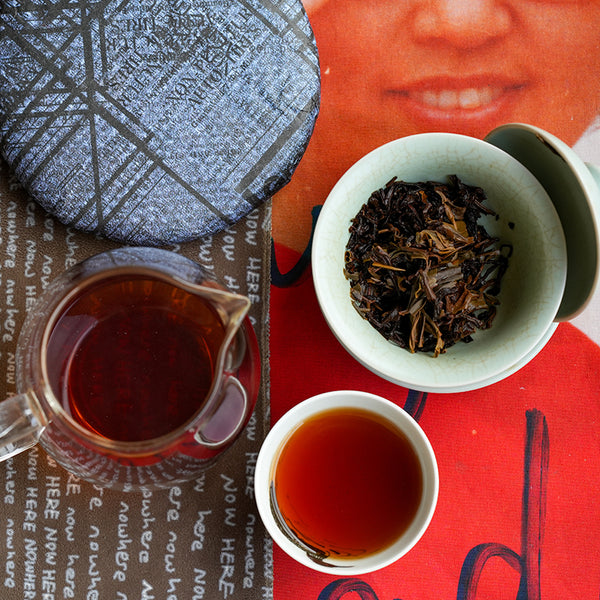
Hybrid style pressing of aged raw Puer maocha and light ferment small batch shou Puer pressed by white2tea in 2024
Hybrid Puer tea styles
Traditionally many factories experimented with pressing both raw and ripe Puer teas together to create a different and enjoyable experience. Enjoying a bit of experimentation ourselves, we have been pressing hybrid style tea cakes such as black and white tea together for many years. We recently also pressed aged raw Puer maocha with lighter fermentation shou Puer batches in blends as well such as our 2024 Riparian and 2024 Jamrock Steady.
Part of what makes both raw and ripe Puer tea so exciting is the nearly endless combinations of flavor profiles and feelings that they can evoke, even without the addition of other flavoring ingredients that we mentioned above.
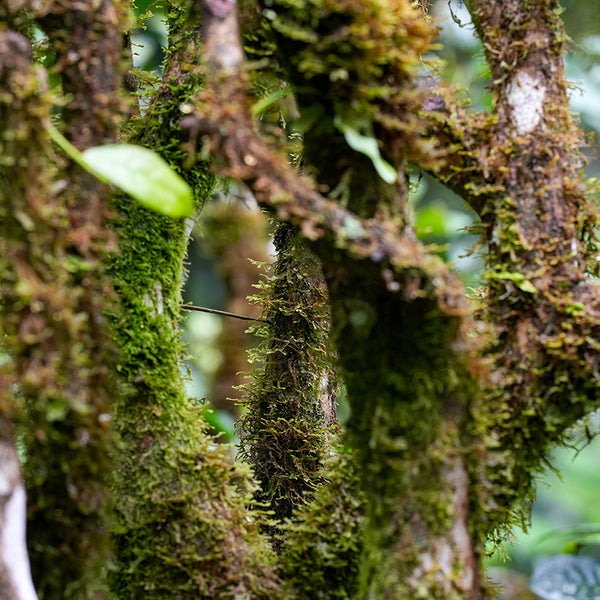
Trees that white2tea considers to be gushu or old tea trees in a Yunnan forest
Tree Age, Plantations and Old Arbor Gushu Puer
Another way in which people subdivide and categorize Puer teas is the age of the plants they are plucked from. Keep in mind the tree age is not the same as the age of the tea leaves, the latter of which is measured from harvest time. Tea plants start small but as they age, they can grow into large, almost primeval behemoths, and can theoretically live hundreds of years, though unfortunately vendors' claims of "500 year old trees'' are generally false.
The least expensive teas in the market come from terraced plantation teas that are called taidi and grown in monoculture. From there, the classifications get murky with terms small tree or xiaoshu, or qiaomu for older trees, with big tree being called dashu and ancient tree being referred to as gushu. You'll also encounter other terms like "old arbor," again pointing to older trees that command a premium price.
These descriptors, much to our chagrin, don’t have all that much credibility/meaning in the broader Puer market. Most unscrupulous vendors exaggerate tree age in order to inflate prices.
Functionally as a Puer drinker, we recommend that you focus on which teas you personally enjoy rather than getting hung up on the pissing contest and whose stated number is bigger. While you can never know for sure if the stated age is correct, you can always trust your experience of drinking what's in your cup.
What you should know is that younger bush material tends to be harsh and brash, whereas older teas tend to be smoother and more complex. You’ll get what you pay for from any honest vendor. We tend to shy away from mentioning tree age at all due to the reasons stated above, but for example, a tea like Green Hype, which is an entry level raw Puer, does not have any old arbor material in it, whereas a tea like 1 Absolution is entirely made of material from very old trees.

Drinking an aged Anhua Heicha, a dark tea from Hunan province
Teas that are Similar to Puer tea, such as Heicha and Dark Tea
To reiterate, Puer has to be from Yunnan province of China in order to be considered Puer tea. So, what about teas that are not from Yunnan province that are produced in a similar manner? These teas are called dark tea or heicha in Mandarin Chinese. Heicha is a broad category of tea that encompasses teas from many provinces in China such as Anhui, Hunan and Guangxi.
Some other countries nearby China such as Thailand and Vietnam also produce similar teas which are often misrepresented as Puer. As with everything else in tea, the label is not really as important as your own enjoyment. If you find a tea that you love and it is not technically Puer tea, who cares; it’s about having fun, not winning a pedantic genre argument at a tea table or internet community. We personally drink a lot of Anhua Heicha on a daily basis, along with our Puer.

A Puer tea bud in the forests of Menghai, Yunnan 2023
Mental and Physical effects from Raw and Ripe Puer tea
Puer tea is a complex chemical cocktail with psychotropic effects that vary from person to person. The combination of chemicals like caffeine, epigallocatechin-3-gallate (EGCG), thousands of different microbial metabolites created during fermentation, and L-Theanine will all tend to have effects on the body and mind of the person drinking the tea, but how an individual tea affects you will be highly personal and vary widely from tea to tea.
At white2tea we aren't too concerned with the chemical compounds, though it's certainly an interesting rabbit hole. You don't need a biochemistry degree to enjoy Puer! On the other hand, some people dismiss the mind-altering effects of Puer as imaginary "woo," which is incorrect; this tea really can make you feel some kinda way.
Different raw Puer and ripe Puer teas can all have a range of effects, with raw Puer and lightly fermented ripe Puer tending to have the more pronounced and interesting effects on both body and mind.
If you’re after more intense caffeine and stimulating teas that have a higher amount of buds will be your best bet, as the buds of the tea plant contain more caffeine than the larger, older leaves. Hence, if you’d like less caffeine, teas that are made with larger, older leaves will contain less caffeine than a bud-heavy Puer.

A simple gongfu session with an aged raw Puer, involving a gaiwan, a tea pitcher and a teacup
How to appreciate Puer tea
First off, the best way to enjoy Puer tea is however you can reasonably make time for it, whether that is tossing a chunk into a mug for grandpa style brewing or whatever else you can muster in your busy schedule.
With that being said, the best way to truly appreciate Puer tea is with gongfu style brewing. While some people fear this is complicated, it’s incredibly simple. All you need is a small teapot or gaiwan, which is a tiny lidded bowl, and a medium-sized cup with a capacity of about 100 ml (3.5 oz) or more. That’s it. If you want to branch out further and get a tea pitcher and some other implements, that will enhance the experience even further and allow you to share with others.
Gongfu brewing is essentially taking a small vessel and some tea, with a roughly 1g per 15ml ratio (6-7 grams of dry tea material goes into a standard 100 ml gaiwan or teapot). Rinse your tea once quickly with boiling water, dump the rinse without drinking it, refill the vessel, and then proceed to steep your tea about 15 seconds for the first steep. Now, unlike Western style, you'll proceed to steep multiple times after this, and the idea is to observe the progression of flavor and other tea characteristics with each subsequent steep.
After your initial steep, add about 5 seconds per steep, or to taste (if the tea is not strong enough, steep longer. If it’s too strong, steep shorter) and continue drinking for as many steeps as you like. Most Puer teas can steep at minimum 8 steeps with this method, with some being able to steep upwards of 15 steeps or more.

Two freshly pressed raw Puer teas from our 2023 spring lineup, notice their bright green color
Raw Puer tea vs. Ripe Puer tea at a glance
|
Raw Puer Tea |
Ripe Puer Tea |
|
|
Dry leaf color |
Green and gold when young, darker when aged |
Reddish brown, maroon, umber, dark brown |
|
Brewed tea color |
Golden yellow when young, orange and darker when aged |
Dark crimson, coffee colored, dark brown when steeped strong |
|
Flavor Profile |
Bright, floral, fruity, bitter, tobacco, sweet (very wide range of diversity) |
woody, petrichor, can also be fruity or even bitter |
|
Characteristic Profile |
Astringent, bitter, intense |
Smooth, full bodied, soft |
|
Suitable for Aging |
Yes |
Yes, but less time is needed to properly age shou, unless it is a lighter ferment |

